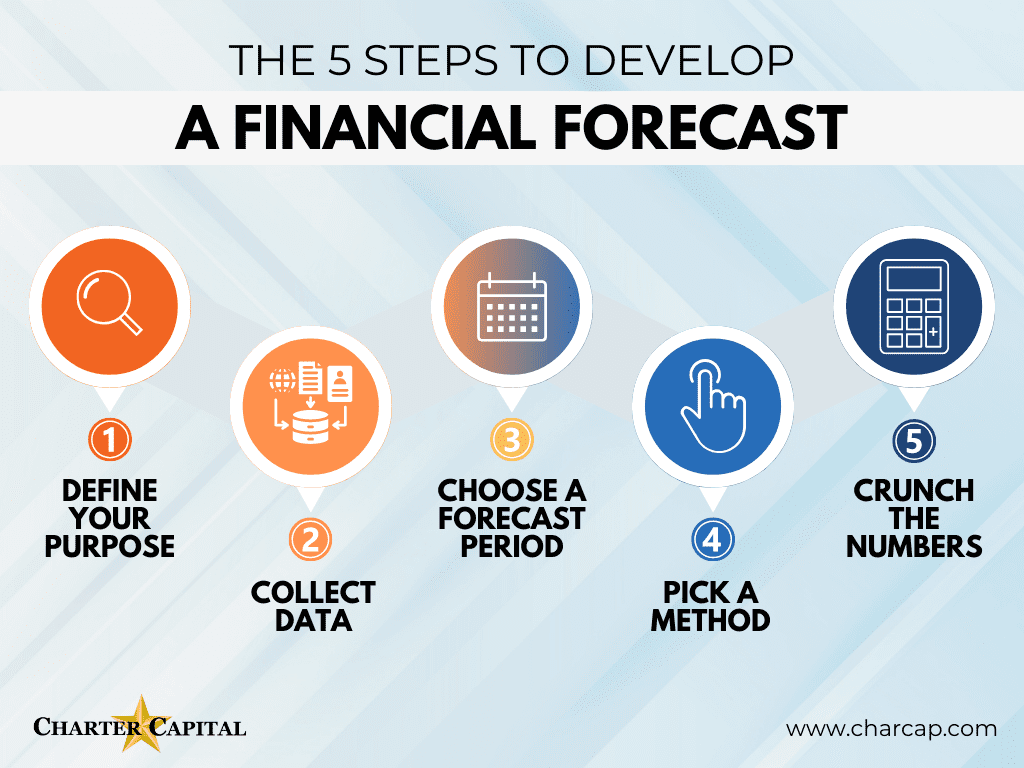
Financial planning and forecasting aren’t things many small business owners think about, but they become more imperative as a company grows. On this page, we’ll walk you through the fundamentals of financial forecasting, why it matters, and how to develop a basic financial forecast for your business.
What is Financial Forecasting?
Financial forecasting is the process of projecting a business’s future performance based on its current and past. It helps with many financial planning activities, including budgeting and financial modeling.
Financial Forecast vs. Budget
A budget is usually set annually and establishes your business’s financial goals. It guides the direction of the company.
A financial forecast outlines what the business can reasonably expect to achieve during a specific period. It can be created annually, quarterly, or monthly and is usually updated regularly. Forecasts help determine whether your business will meet its goals during the period you’re examining.
Types of Financial Forecasting
There are many types of financial forecasting a business might perform. A few examples are highlighted below:
Cash Flow Forecast
A cash flow forecast predicts how much cash will flow in and out of your business during a set period and whether you’ll have enough cash to cover expenses.
Expense Forecast
An expense forecast outlines all accounts payable your business expects to pay during a set period to help ensure you’re prepared for them.
Sales Forecast
A sales forecast anticipates future sales, making it easier for the business to meet demand or manage inventory.
Startup Cost Forecasting
Startup cost forecasting predicts how much a new business will spend.
Financial Forecasting Models
There are four main types of forecasting models: top-down, bottom-up, Delphi, and statistical.
Top-Down Financial Forecasting
With the top-down method, you identify the total market size and calculate revenue based on your assumed market share. It’s not a precise method, but it can be a good starting point, especially for businesses without historical data.
Bottom-Up Financial Forecasting
The bottom-up method works as the name suggests. Rather than starting with broad market data, you begin with your sales volume or units from the previous period and multiply it by what you expect to charge for the coming period. It’s a more precise method, but it can be time-consuming, and any errors made in the early stages of the calculations are amplified as the calculations continue.
Delphi Financial Forecasting
With the Delphi method, a group of experts receive the company’s financial data and are asked to make predictions. When the predictions are received, the experts each receive a summary and are asked to create new predictions, a process that continues until the group reaches a consensus. The process can be somewhat unpredictable and take an extended period, but it’s more objective than traditional in-house forecasting.
Statistical Financial Forecasting
Any form of forecasting that leverages historical quantitative data falls under the umbrella of statistical financial forecasting. It’s more straightforward and accurate than other methods, but businesses without historical data may not be able to produce reliable results.
Financial Forecasting Methods
There are just as many forecasting methods as there are forecasting models.
Straight Line
The straight-line method is arguably the more common and straightforward method. It simply involves pulling past figures to calculate historical growth and assumes the business will continue growing at the same rate. For instance, if your business grew three percent last year, this model assumes you’ll also grow by three percent this year.
Simple Linear Regression
The simple linear regression method is used to explore the relationship between an independent and dependent variable. For instance, you might use the simple linear regression method to determine how GDP shifts will impact your revenue.
Multiple Linear Regression
Multiple factors impact a variable more often than not. In these cases, the multiple linear regression forecasting method is required.
Moving Average
The moving average method is sometimes used over shorter periods, such as quarters, months, or weeks. It involves calculating the mean of a dataset and applying the trend to future projections.
Why Financial Forecasting is Important for Your Business
Now that we’ve covered how financial forecasting works, let’s explore why it should become part of your everyday business activities.
It Helps Measure Your Progress
Forecasting can tell you if you’re on track to meet your financial goals. If not, it can also help you see where you’re falling short and help you strategize ways to get back on track.
It Helps You Identify Potential Issues
If you’re performing regular forecasts, you’ll likely spot issues before they become serious problems when they’re easier to correct.
It Can Help Prevent Tax Surprises
If your business grows rapidly, your projections can help you make more accurate tax payments, so you’re not surprised by a huge bill later.
Enhancing Your Business’s Financial Health with Effective Forecasting
Creating a robust financial forecast is a key step for any small business owner aiming to ensure their business’s longevity and growth. A comprehensive financial forecast involves more than just predicting future sales; it’s about creating a realistic picture of your business’s financial future. This includes generating detailed pro forma financial statements, which project your income statement, balance sheet, and cash flow statement. These projections show not only your expected revenue and expenses, including operating expenses and cost of goods sold, but also illuminate potential cash flow needs and liabilities.
For startups and established small businesses alike, mastering the art of financial forecasting is vital. It’s a process that combines historical data analysis with assumptions about future business conditions. This approach helps you make informed business decisions, plan for what’s ahead, and prepare for both short-term and long-term financial changes in your business. Utilizing tools like accounting software and financial planning software can greatly aid in this process, providing valuable financial insights and making the forecasting process more manageable.
Creating financial forecasts and cash flow projections are indispensable for planning your company’s financial strategy. This is not just about handling your current business finances; it’s about envisioning the future of your business. With a solid financial forecast, you can effectively manage business growth, secure business loans, and adapt your business strategy to meet changing market conditions. Learning how to create and interpret these forecasts allows you to plan for your business’s financial health and can significantly impact how your business is headed.
In essence, financial forecasting for small businesses isn’t just a task—it’s an ongoing process that helps you grow and sustain your business. By creating accurate and research-based forecasts, you can understand where your business might be in the future, helping you stay prepared and proactive in all your business endeavors.
How to Develop a Financial Forecast for Your Business
While you can use financial forecasting software to tackle your projections, you can also address them independently.
1. Consider Your Purpose
Knowing what you want to get out of your financial forecast will help you plan better.
2. Gather Your Data
In most cases, you’ll be gathering historical data related to:
- Revenue and losses
- Fixed costs
- Equity and liabilities
3. Determine Your Forecast Period
Again, most forecasts look at smaller slices of time, such as a year or less into the future. The unique needs of your business will determine your forecast period.
4. Select a Financial Forecasting Method
If you’re performing manual calculations, the straight-line method may be easiest, but you can also experiment with other financial forecasting methods as needed.
5. Run Your Calculations
Perform your calculations and analyze your results. Remember that the same data set and calculations can provide different insights depending on your preferences.
Let Charter Capital Help You with Your Short-Term Shortfalls
Oftentimes, a temporary lack of working capital rather than a lack of profit causes issues for small businesses. This happens when cash flow is sluggish due to slow-paying clients or seasonality. Rapid growth is a common cause of cash flow gaps, too. Thankfully, businesses can often catch these issues with proper forecasting and take steps to address the shortfall before it becomes a problem.
Invoice factoring helps by accelerating payment on your receivables so your business can close cash flow gaps without taking on debt. To get started, request a complimentary factoring quote from Charter Capital.

- How to Use ChatGPT for Answers, Inspiration & Productivity - April 14, 2025
- How Factoring Supports Business Continuity Plans - March 17, 2025
- Factoring vs. Supply Chain Financing: Which is Right for You? - February 17, 2025

